NGC Ancients: Pergamene Coinage under the Romans
Posted on 2/9/2021
In the previous column we surveyed the Greek coinage of Pergamum, a powerful fortress-city in northwest Asia Minor about 15 miles inland from the Aegean Sea. There we noted that under its king Eumenes II (197-159 B.C.), Pergamum became a strong ally of Rome — a foreign power that recently had taken an interest in dominating the Near East.
Eumenes II supported Rome in its war against the Seleucid King Antiochus III (222-187 B.C.), which culminated in a victory at Magnesia in 190 B.C. and a treaty, the Peace of Apamea.
When Pergamum’s last king Attalus III (139/8-133 B.C.), who had no legitimate sons or heirs, died in 133 B.C., he bequeathed his kingdom to Rome, which then assumed the responsibility of issuing Pergamene coins.
 |
Though struck after the Romans had inherited the Pergamene empre, the coin above was not issued by the Romans, but by Aristonicus, a rebel who sought to restore the independence of Pergamum. Aristonicus claimed to be an illigetimate son of the former king Eumenes II, and thus assumed the name Eumenes III as he pursued his hopeless cause from c.133 to 129 B.C. He issued cistophori at three cities, Apollonis, Stratoniceia and Thyatira, with the example above being from Thyatira.
 |
The silver didrachm (half-cistophorus) above was struck at Pergamum by the Romans in the period 123 to 104 B.C. Significantly rarer than cistophori, these coins bear on their obverse a Herculean lion skin draped over a club, within an ivy wreath, and on their reverse a grape cluster upon a vine leaf.
 |
 |
 |
 |
A great many bronze coins were struck at Pergamum by the Romans, both when Rome was still a republic and when, in 27 B.C., historians consider Rome to have became an empire. Above are four examples from the early period, c.133-27 B.C., all of which portray on their obverse the goddess Athena. The first shows on its reverse Nike; the second an owl on a palm frond; the third a standing owl; the fourth a military trophy.
 |
 |
 |
 |
Also from the period c.133-27 B.C. are the four Pergemene bronze coins above, all of which portray the healing-god Aesculapius. The reverses of the first two show an eagle standing on a thunderbolt; the third shows a coiled serpent; the fourth a serpent-entwined staff.
 |
 |
 |
Above are three cistophori issued at Pergamum under Roman rule. They bear the usual types: a cista (a sacred basket) from which a serpent escapes and a bow in its case, flanked by serpents. Scholars date the first two to c.96-92 B.C. and the third to c.85-76 B.C.
Roman authority in Asia Minor was challenged by wars and uprisings fomented by the Pontic king Mithradates VI (120-63 B.C.). Indeed, he captured many important cities in the Greek world, including Athens and Pergamum.
 |
 |
Above are two ancient coins of this belicose king, showing on their obverses his portrait and on their reverses a wreath around a drinking stag. These coins bear precise dates. First is a gold stater dated to September, 74 B.C.; next is a silver tetradrachm dated to August, 75 B.C.
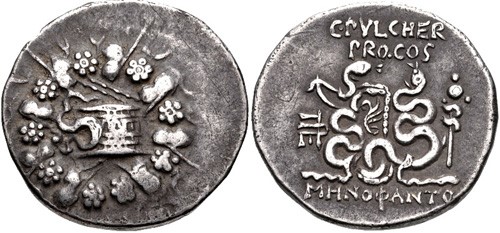 |
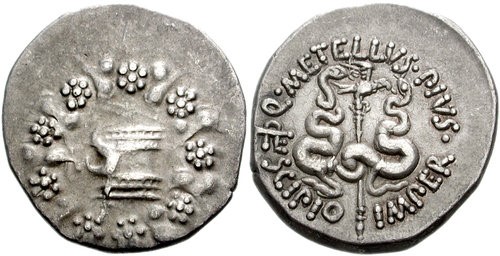 |
After Mithradates VI was defeated, Rome struck more coinage at Pergamum, including the two ‘proconsular cistophori’ (above) — so-called because they bear the names of Roman proconsuls with authority in the region. The first names the proconcul C.Claudius Ap.f. Pulcher and is dateable to 55-53 B.C.; the second names the imperator and proconsul of Syria Q.Caecilius Metellius Pius Scipio, and is dateable to 49-48 B.C.
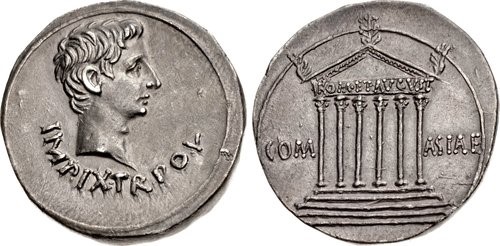 |
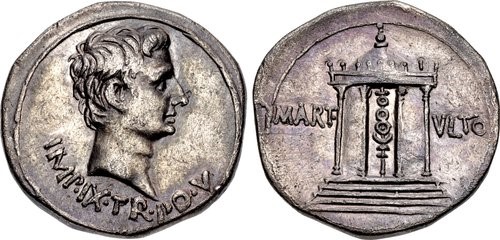 |
 |
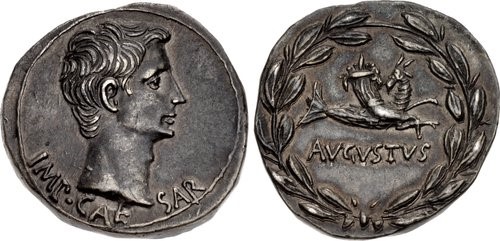 |
Pergamum may also have been the mint for some very large issues of cistophori bearing the portrait of Rome’s first emperor, Augustus (27 B.C.-A.D. 14), though this is not certain. A selection of four are shown above.
The reverse types, from top to bottom, are: a tetrastyle temple of Rome and Augustus; a signum within a round temple of Mars Ultor; a triumphal arch of Augustus surmounted by a quadriga; a capricorn with a cornucopia at its shoulder.
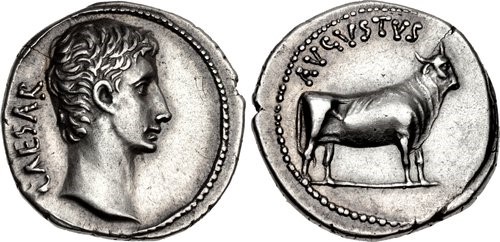 |
 |
Other ancient coins often attributed to Pergamum include silver denarii with the portrait of Augustus. Above are two possible issues of that mint, the first showing on its reverse a standing heifer, the second with a crocodile and the inscription AEGYPTO CAPTA.
During Roman times, Pergamum retained its traditional importance, being counted among the three great cities of Rome’s Province of Asia. Its coinage in this period was both practical and celebratory — a reflection of the city’s exalted status.
Below, a very small sampling of these coins is presented.
 |
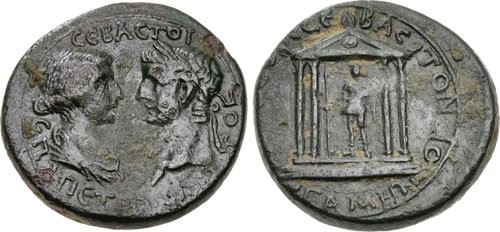 |
 |
All three of the coins above are Julio-Claudian. The first, an issue of A.D. 14-29, portrays Augustus’ wife (Livia) and daughter (Julia). The second portrays Livia and her son, the emperor Tiberius (A.D. 14-37). The third is an ‘autonomous’ bronze with portraits representing Rome and the Senate struck under the emperor Claudius (A.D. 41-54) or Nero (A.D. 54-68).
 |
 |
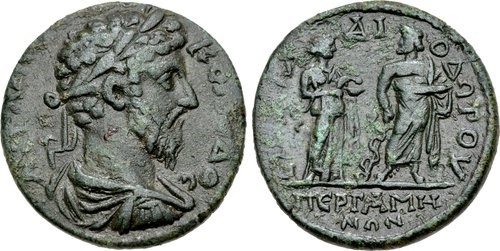 |
From the era of the Adoptive Emperors are three Pergamene bronzes shown above. The first portrays the emperor Trajan (A.D. 98-117) and the god Zeus; the second the empress Sabina (A.D. 128(?)-136/7) and Koronis (a mortal lover of the god Apollo); the third the emperor Commodus (A.D. 161-180) and the gods Hygieia and Aesculapius.
 |
Another provincial bronze of Pergamum is the 43mm ‘medallion’ above which shows the confronted portraits of the emperor Septimius Severus (A.D. 193-211) and his wife, the empress Julia Domna. The reverse shows a Victimarius preparing to strike a sacrificial bull beneath a statue of the emperor set on a cippus.
The final issues we’ll examine are homonoia coinages, better known as ‘alliance coins’ because they celebrate what amounted to spiritual brotherhoods of two cities, which often were supported by commercial, religious or ancestral ties. Sometimes the cities were close neighbors, other times they were quite far apart.
 |
 |
Above are two homonoia coins from the reign of Augustus. The first was issued at Pergamum and reflects its alliance with Sardes, an important city in Lydia. The second celebrates the same relationship, but was issued at Sardes.
 |
 |
We’ll close with two alliance ‘medallions’ issued at Pergamum in celebration of its homonoia with the Ionian city of Ephesus. First is a 42mm bronze struck for the emperor Commodus; second is a 39mm bronze of the emperor Gallienus (A.D. 253-268).
All photos courtesy of Classical Numismatic Group.
Learn more about Pergamene coinage under the Greeks.
Interested in reading more articles on Ancient coins? Click here.
Stay Informed
Want news like this delivered to your inbox once a month? Subscribe to the free NGC eNewsletter today!
